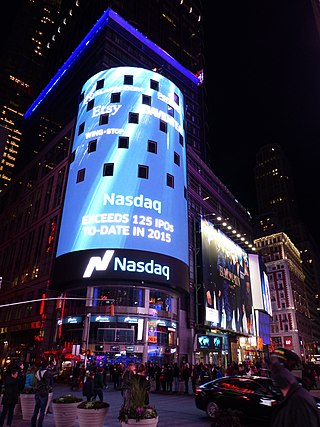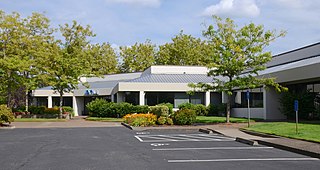
London Stock Exchange (LSE) is a stock exchange in the City of London, England, United Kingdom. As of November 2021, the total market value of all companies trading on LSE was £3.9 trillion. Its current premises are situated in Paternoster Square close to St Paul's Cathedral in the City of London. Since 2007, it has been part of the London Stock Exchange Group. The LSE was the most-valued stock exchange in Europe from 2003 when records began until Autumn 2022, when the Paris exchange was briefly larger, until the LSE retook its position as Europe's largest stock exchange 10 days later. According to the 2020 Office for National Statistics report, approximately 12% of UK-resident individuals reported having investments in stocks and shares. According to the 2020 Financial Conduct Authority (FCA) report, approximately 15% of UK adults reported having investments in stocks and shares.

Cypress Semiconductor was an American semiconductor design and manufacturing company. It offered NOR flash memories, F-RAM and SRAM Traveo microcontrollers, PSoC programmable system-on-chip solutions, analog and PMIC Power Management ICs, CapSense capacitive touch-sensing controllers, Wireless BLE Bluetooth Low-Energy and USB connectivity solutions.

U.S. Bancorp is an American bank holding company based in Minneapolis, Minnesota, and incorporated in Delaware. It is the parent company of U.S. Bank National Association, and is the fifth largest banking institution in the United States. The company provides banking, investment, mortgage, trust, and payment services products to individuals, businesses, governmental entities, and other financial institutions. It has 3,106 branches and 4,842 automated teller machines, primarily in the Western and Midwestern United States. It is ranked 117th on the Fortune 500, and it is considered a systemically important bank by the Financial Stability Board. The company also owns Elavon, a processor of credit card transactions for merchants, and Elan Financial Services, a credit card issuer that issues credit card products on behalf of small credit unions and banks across the U.S.
Lattice Semiconductor Corporation is an American semiconductor company specializing in the design and manufacturing of low power, field-programmable gate arrays (FPGAs). Headquartered in the Silicon Forest area of Hillsboro, Oregon, the company also has operations in Shanghai, Manila,Los Angeles and Singapore. Lattice Semiconductor has more than 700 employees and an annual revenue of more than $400 million as of 2019. Founded in 1983, the company went public in 1989 and is traded on the NASDAQ stock exchange under the symbol LSCC.
Planar Systems, Inc. is an American digital display manufacturing corporation with a facility in Hillsboro, Oregon. Founded in 1983 as a spin-off from Tektronix, it was the first U.S. manufacturer of electroluminescent (EL) digital displays. Planar currently makes a variety of other specialty displays, and is an independent subsidiary of Leyard Optoelectronic Co. since 2015.The headquarters, leadership team and employees still remain in Hillsboro, Oregon.

Nasdaq, Inc. is an American multinational financial services corporation that owns and operates three stock exchanges in the United States: the namesake Nasdaq stock exchange, the Philadelphia Stock Exchange, and the Boston Stock Exchange, and seven European stock exchanges: Nasdaq Copenhagen, Nasdaq Helsinki, Nasdaq Iceland, Nasdaq Riga, Nasdaq Stockholm, Nasdaq Tallinn, and Nasdaq Vilnius. It is headquartered in New York City, and its president and chief executive officer is Adena Friedman.

Papa Murphy's is a take-and-bake pizza company based in Vancouver, Washington. It began in 1995 as the merger of two local take-and-bake pizza companies: Papa Aldo's Pizza and Murphy's Pizza. The company and its franchisees operate more than 1,300 outlets in the United States, Canada and the United Arab Emirates. On April 2019, it was announced that the company would be acquired by MTY Food Group for $190 million.
Click Commerce, Inc. is a research software company based in Hillsboro, Oregon, United States. Incorporated in 1996 as Click Interactive, Inc. in Chicago, Illinois, the company historically supplied business application software and related services.
Radisys Corporation is an American technology company located in Hillsboro, Oregon, United States that makes technology used by telecommunications companies in mobile networks. Founded in 1987 in Oregon by former employees of Intel, the company went public in 1995. The company's products are used in mobile network applications such as small cell radio access networks, wireless core network elements, deep packet inspection and policy management equipment; conferencing, and media services including voice, video and data. In 2015, the first-quarter revenues of Radisys totaled $48.7 million, and approximately employed 700 people. Arun Bhikshesvaran is the company's chief executive officer.

Strategic Education, Inc. (SEI), is an education services holding company and is formerly known as Strayer Education, Inc. The company owns for-profit, online Capella University and Strayer University, as well as non-degree programs schools such as DevMountain, Hackbright Academy, and Sophia Learning.

Merix Corporation was an American printed circuit board (PCB) manufacturer based in Beaverton, Oregon. Prior to a merger in 2010 with Viasystems, the company had been the 31st largest public company in Oregon based on market capitalization as of 2006. The company is now part of TTM Technologies.

London Stock Exchange Group plc (LSEG) is a United Kingdom-based stock exchange and financial information company headquartered in the City of London, England. It owns the London Stock Exchange, Refinitiv, LSEG Technology, FTSE Russell, and majority stakes in LCH and Tradeweb.

TriQuint Semiconductor was a semiconductor company that designed, manufactured, and supplied high-performance RF modules, components and foundry services. The company was founded in 1985 in Beaverton, Oregon before moving to neighboring Hillsboro, Oregon. In February 2014, Greensboro, North Carolina-based RF Micro Devices and TriQuint announced a merger in which the new company would be Qorvo, Inc., with the merger completed on January 1, 2015.

The Pacific University Health Professions Campus is a satellite campus of Pacific University located in downtown Hillsboro, Oregon, United States. Opened in 2006, the campus contains the school's College of Health Professions with plans to move Pacific's College of Optometry and School of Professional Psychology in later phases. Housed in two brick buildings, the campus is located in the city's Health and Education District and adjacent to the Tuality Hospital/Southeast 8th Avenue light rail station. The campus of Tuality Community Hospital is across Baseline Street to the south.
The OGI School of Science and Engineering, located in Hillsboro, Oregon, United States was one of four schools at the Oregon Health and Science University (OHSU). Until June 2001, it functioned independently as a private graduate school, the Oregon Graduate Institute of Science & Technology (OGI). OGI operated four departments and had approximately 330 students. In 2008, the school's name was changed to the Department of Science and Engineering and by 2010, the department was dissolved and the academic programs and research were disseminated to other OHSU institutes and departments.

Phoseon Technology is a privately owned electronic manufacturing company based in Hillsboro in the U.S. state of Oregon. Founded in 2002, the company makes products that use ultraviolet light produced by light emitting diodes (LED) that are used for curing products in industrial settings. Phoseon is located in the Portland metropolitan area and has offices in Europe and Asia. Bill Cortelyou is the chief executive officer and president of the firm.
Electro Scientific Industries, Inc. (ESI) is an American high technology company headquartered in the Portland, Oregon, metropolitan area, specifically in Beaverton, Oregon, since 2021, but from 1963–2021, it was based in the unincorporated Cedar Mill area just north of Beaverton. ESI is a developer and supplier of photonic and laser systems for microelectronics manufacturers. Founded in 1944, it is the oldest high-tech company in Oregon. Along with Tektronix, and later Intel, it has spawned numerous technology-based companies in the Portland area, an area known as the Silicon Forest. From 1983 to 2019, shares in the company were publicly traded on NASDAQ, under the ticker symbol ESIO.
Cascade Microtech is a semiconductor test equipment manufacturer based in Beaverton in the Portland metropolitan area of the United States. Founded in 1983, the Oregon-based company employs nearly 400 people. Formerly publicly traded company as CSCD on the NASDAQ, the company is now fully merged with FormFactor, Inc.

Enli Health Intelligence was a privately held software company based in Beaverton, Oregon, and previously in Hillsboro, Oregon. Founded in 2001, as Kryptiq Corporation, the company specialized in electronic medical records and secure communications between physicians and patients. The 125-employee company was purchased by Surescripts in 2012, which was a previous investor in the company. Annual revenues at the time of the sale were approximately $25 million. In January 2015, the company announced that it was splitting from Surescripts and becoming independent again. Later in 2015, it was renamed Enli Health Intelligence later. In 2021, it was acquired by Cedar Gate Technologies, which discontinued use of the Enli name.

Qorvo is an American semiconductor company that designs, manufactures, and supplies radio-frequency systems for applications that drive wireless and broadband communications, as well as foundry services. The company, which trades on NASDAQ, was created by the merger of TriQuint Semiconductor and RF Micro Devices, which was announced in 2014 and completed on January 1, 2015. The headquarters for the company originally were in both Hillsboro, Oregon, and Greensboro, North Carolina, but in mid-2016 the company began referring to its North Carolina site as its exclusive headquarters.













